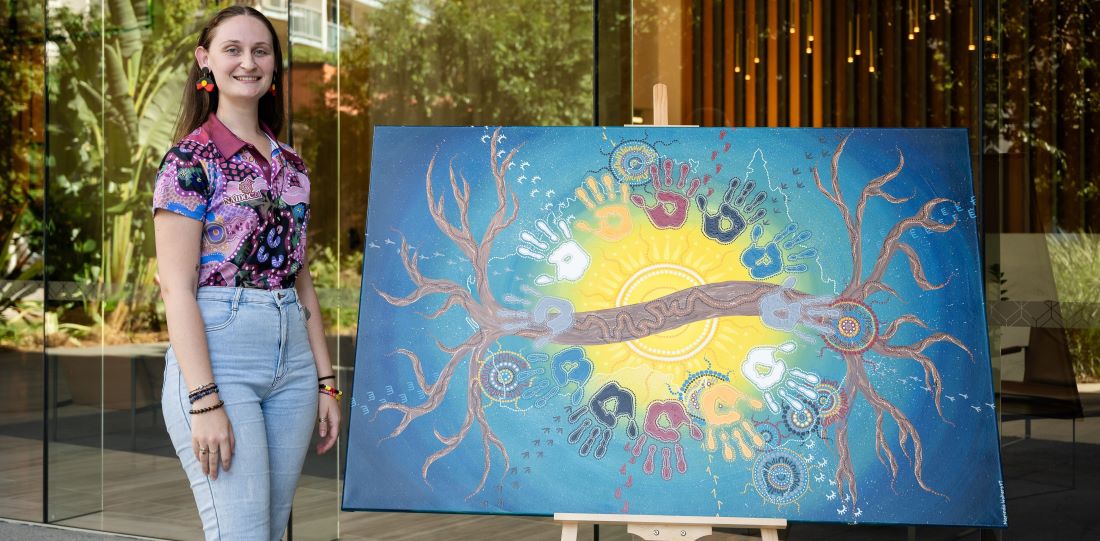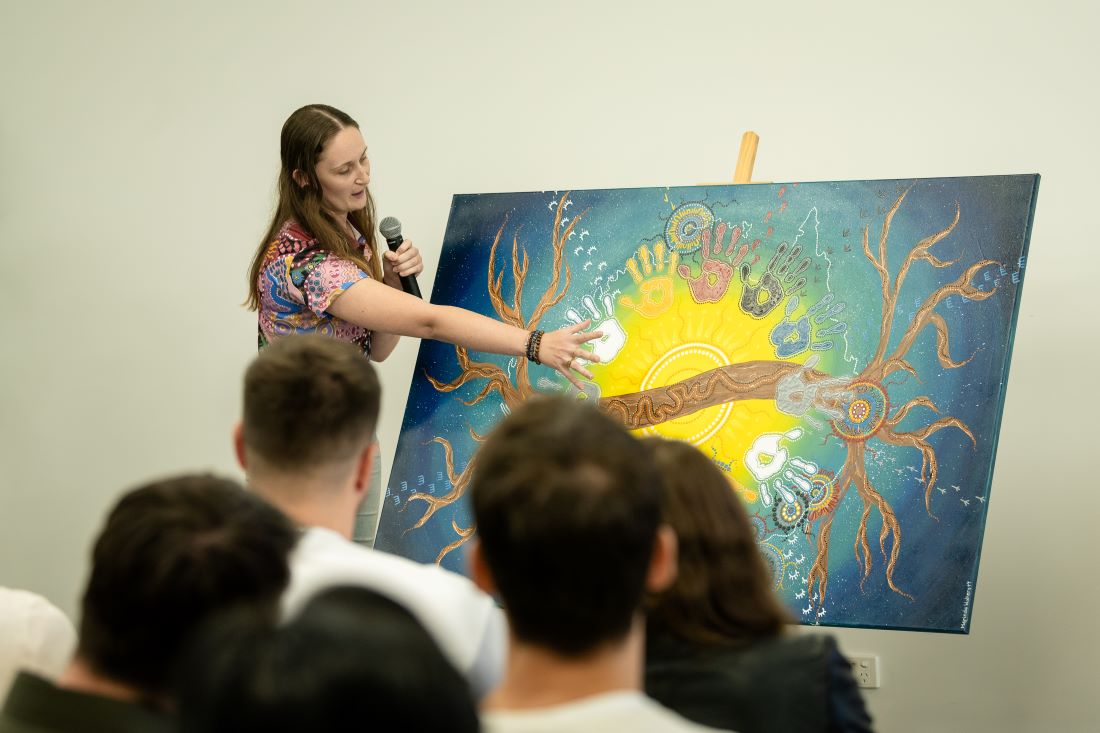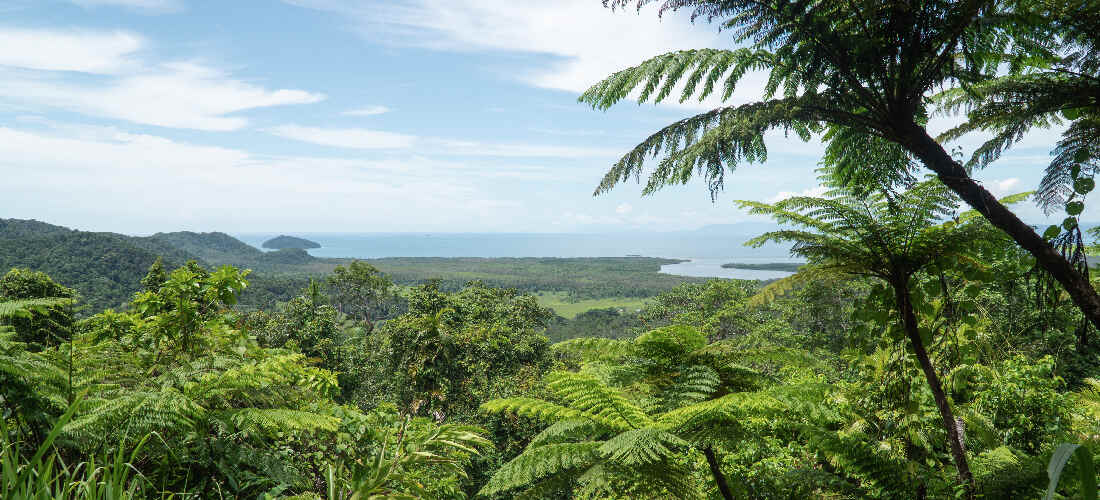
First Nations methods and meaning used to mark 150 years of BOQ
How do you express the history of one of Australia’s oldest banks in one piece of art?
You use the even older methods and techniques that Australia’s first peoples have used to learn and retain knowledge for tens of thousands of years.
To mark our significant milestone of 150 years of BOQ, we commissioned First Nations artist Merinda Walters to create a piece that reflected our 150 years of history, legacy, and ties to the state of Queensland.
The artwork was recently unveiled at BOQ’s head office in Brisbane as part of NAIDOC Week 2024 events.
‘One of my passions is to elevate Indigenous methods and show how they work in western fields,’ says artist Merinda, a Kamilaroi woman, who applies those methods to both her painting and her work as an environmental scientist.
The resulting artwork, called Burrul gi-gi Magula (meaning growing together in Kamilaroi, an original language of southern Queensland and northern New South Wales areas), is a celebration of the past 150 years and a promise for the future.

Artist Merinda Walters talks staff through BOQ 150 years commemmoration artwork, created with the help of BOQ co-design group.
In an Aboriginal worldview, knowledge isn’t written, but transferred through relationships and stories, which collects and distributes learning.
To find the path to create the relationships and stories of the artwork, Merinda connected through yarning with a focus group of participants from across the offices and business units of BOQ Group.
‘We had two virtual yarning circles that linked up right across the country,’ says Merinda.
She explains that the yarning process is more than a conversation. It’s a structured activity of non-hierarchical active listening and consensus-finding that’s recognised for group knowledge production, inquiry, and transmission. The process connected her ideas with the group’s experiences of working with the bank.
‘Yarning circles are great; it helps bring people out of their shells and they really help my art,’ she says.
Managers for banking capability, Shannon Sarow, and community investment, Laura Churchill, were both part of those yarning circles.
‘Our role was to consider our own insights and share what BOQ’s values mean to us, our customers and community, and what makes BOQ different,’ says Shannon. ‘The ideas flowed, and people started to build and expand on the insights and found key words being repeated.’
‘It was interesting – but not surprising – that the same themes continued to arise throughout the collaboration session – community, togetherness, warmth,’ says Laura, adding that Merinda was able to draw these out and clarify what she was hearing.
The artwork, which was revealed to staff during BOQ’s NAIDOC Week events, is a meld of modern colour with the very old traditions of sand, bark, and rock paintings being used as memory guidelines for things like the Songlines – the mental maps that allowed First Nations peoples to navigate and live across the continent.
Like modern mapping, this style is seen from a bird’s eye view – an extraordinary ability Aboriginal people had thanks to spatial awareness and systems that come with deeper relationships to the land. These maps reminded First Nations peoples how to connect with the country: where to go, to camp, to gather, find water and food, and where to avoid. Told through stories and songs handed down.
‘This map is to remind BOQ where it comes from, the relations it values and where it is going,’ says Merinda.
Both Shannon and Laura applauded the end result. ‘I love it. I can see the things that make BOQ different,’ says Shannon. ‘Merinda has done an amazing job in capturing the essence of our organisation.’
Brisbane locals may recognise the pattern adorning the centre of the tree as the outline of the Brisbane River where, in 1874, BOQ began as the community-based Brisbane Permanent Benefit Building and Investment Society, which saw members pool their funds to lend to other members in the development of Brisbane and modern Queensland.
Take a broader focus on the artwork, and you’ll see these all sit on the very faint – almost hidden – outline of Australia. Each gathering circle represents Australia’s major population centres of Darwin, Perth, Adelaide, Melbourne, Launceston, Canberra, Sydney, and Brisbane, showing BOQ is a bank for all Australians.
You’ll also see a series of eight circles made up of smaller circles within them. These are very old symbols for meeting places. And the U-shapes within them mimic the pattern of a person sitting on the ground.
Finally, overlaying all else, are 12 handprints that sit on the golden circle’s penumbra with the blue sky. This represents the work in communities, and BOQ’s focus on working with people across the country.
‘It was a thing I heard very strongly thanks to the yarning circles: that BOQ’s people pride themselves on working in the communities they serve,’ Merinda says.
BOQ celebrates 150 years.
Find out more about our Human Kind of Bank.


